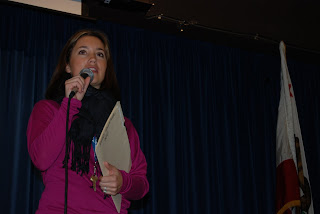
I recently read an interesting article by Blackely on differentiated instruction entitled
Finding Lost Children Through Differentiated Instruction (ASCD Education Update January 2003, Vol. 45, Number 1) The author cites noted educator Carol Ann Tomlinson in her discussion of the importance of differentiated instruction:
"What the research shows...is that, if the brain is to work at its optimum level and if children are to achieve, they must have moderately challenging work—"relative to the learner"—available to them. Work in the classroom must provide an appropriate challenge for each student. "When challenges and skills are in balance," Tomlinson concluded, all students can participate in learning and find that they belong in the classroom."
At AEACMS, the teaching staff is committed to differentiating instruction so that all students are appropriately challenged as they work towards mastery of standards. Please read Ms. Culbertson's (6th grade math) account of the rewards of differentiating instruction:

Why differentiating instruction?
A classroom perspective by Sylvia Culbertson
February, 2008
Developing an instructional plan that will be challenging, enlightening, and intriguing to students of different abilities, and still maintain a sense of community within the classroom, is always in the back of my mind. Differentiating instruction so that the needs of advanced and gifted students are met seemed like an avenue to implement project based learning. I wanted these students to be involved in educational experiences that are challenging and appropriate to their needs and achievement levels.
Who should participate in the projects?There were two criteria in the selection process of these students: 1) a score of 88% or higher on NWEA MAP tests; 2) a consistent 90% or higher score on all classroom assessments.
The students I picked always get their work done quickly and seek further assignments or direction. Secondly, they ask probing questions that tend to differ from their classmates in depth of understanding and frequency. Finally, they have interests in areas that are unusual or more like the interests of older students. These students potentially differ from their classmates on three key dimensions: (1) the pace at which they learn; (2) the depth of their understanding; and (3) the interests that they hold.
How does it work?The project based learning (PBL) I am following has a goal of engaging students in learning knowledge and skills through an extended inquiry process structured around complex, authentic questions and carefully designed products and tasks. Evidence shows that PBL enhances the quality of learning and leads to higher-level cognitive development through students' engagement with complex, novel problems. It is also clear that PBL teaches students complex processes and procedures such as planning and communicating.
My goals for these students are as following:
* Recognize students' capability to do important work by putting them at the center of the learning process.
* Require the use of essential tools and skills for learning, such as self-management, and project management.
* Specify products that solve problems, explain dilemmas, or present information generated through investigation, research, or reasoning.
* Include multiple products that permit frequent feedback and consistent opportunities for students to learn from experience.
* Use performance-based assessments that communicate high expectations, present rigorous challenges, and require a range of skills and knowledge.
* Encourage collaboration in some form, either through small groups, student-led presentations, or whole-class evaluations of project results.
* Encourage the development of habits of mind associated with lifelong learning, and personal success
* Integrate curriculum areas and thematic instruction.
* Assess performance on content and skills using criteria similar to those in the work world, thus encouraging accountability, goal setting, and improved performance.
* Create positive communication and collaborative relationships among diverse groups of students.
How is it going?So far students have been responding very positively to these projects, but as every challenging opportunity this also is a learning process being molded and evolving with every step.
Some of the students have gone above and beyond the required tasks, but it also happened that one of the students got frustrated with the amount of group work and independence the work required. I asked her to come back and join our class discussions and assignments instead. By the end of the lesson this student felt like she understood the content of the assignment based on what I was teaching to the class and she wanted to rejoin her group the next day.
I truly enjoy seeing the excitement that the students show when they come up with a solution or an end product by themselves. Some of them come up to me towards the end of the class and want to present their findings to the rest of the class which clearly shows their level of engagement. I have also heard some students proudly tell others that “ We are basically teaching ourselves! Isn’t this cool?”















































